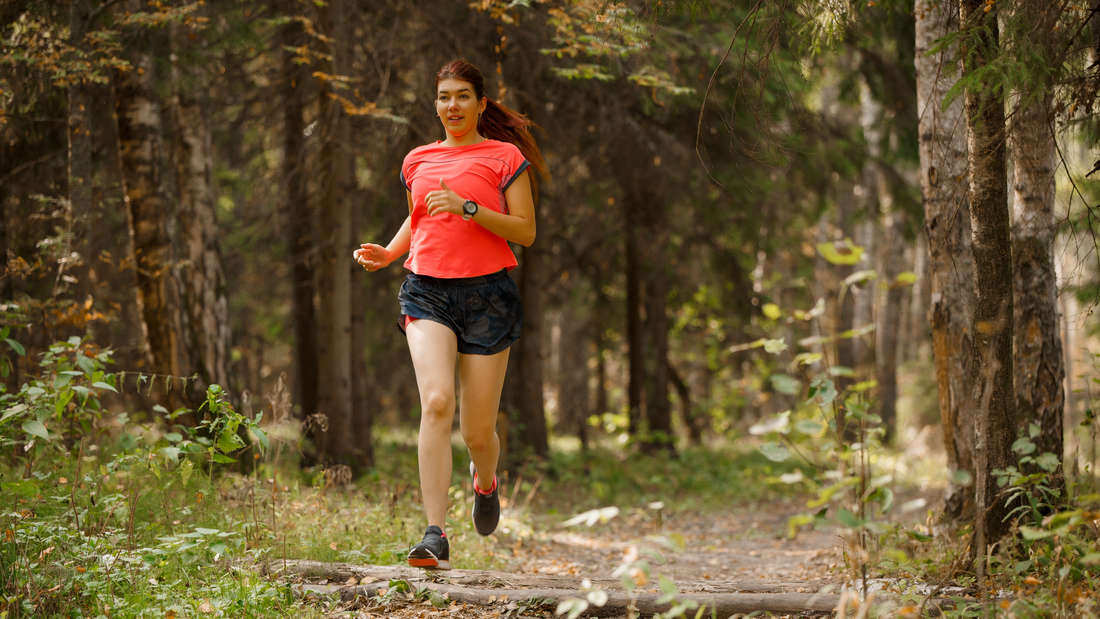
That’s how effective it is for fitness and health
Press
Trail running is trendy. And rightly so, because running off-road not only benefits endurance and strength, but also the mind. You can find out who trail running is suitable for here.
Tired of jogging on hard asphalt over and over again? Then it’s time to head off into the field! Trail running is booming, which is reflected not least in the numerous products that sporting goods manufacturers are flooding the market with. One of the main reasons for the sport’s popularity is its simplicity: put on your running shoes and off you go. There are suitable trails not only in the spacious countryside in the countryside, in forests or in the mountains, but also in urban areas. Find out here what positive effects trail running has on health and fitness.
What is trail running?

When many people think of trail running, they immediately think of exhausted endurance athletes who cover extreme distances and altitudes in alpine terrain. But this is just a particularly excessive form of outdoor sport. The English word “trail” means something like “path”. Trail running means nothing more and nothing less than leaving the asphalt road and running on unpaved off-road paths, paths in the forest or park or, more generally, into nature.
Depending on your fitness level and goals, there are different types of trail running, such as: B. Cross Trail (jogging on small paths in nature, including slopes) or Ultratrail (cross-country runs with a distance of more than 42 kilometers). In the most extreme ones, such as the Mont Blanc Ultratrail, the fastest participants cover 170 kilometers and 10,000 meters in altitude in around 24 hours.
Read more: Find the optimal heart rate range for hiking
What does trail running train for?
You don’t have to log hundreds of miles on trails to reap the physical benefits of off-road running. Running on the trail – whether forest path, gravel path or dirt path – trains muscles, tendons and ligaments differently than running on the road or treadmill. When trails lead uphill and downhill, runners not only strengthen their cardiovascular system and endurance capacity particularly effectively through the high levels of stress. The muscles throughout the body are also trained, especially:
- Front of the thigh (M. Quadriceps femoris): The thigh extensor works primarily downhill in the braking movement (eccentric) and thus enables a controlled running pace.
- Gluteus (gluteus maximus, medius and minimus): When running uphill, the gluteal muscles provide strength and they also provide lateral stability when overcoming obstacles on one leg.
- Calves (M. triceps surae): The calves are particularly stressed in hilly terrain and on technical trails.
- Core: With every step on rough terrain, core muscles in the stomach and back are activated to stabilize the body.
Trail running also strengthens skills such as balance, flexibility and coordination. Because the various obstacles (roots, stones, holes, ditches, …) that have to be overcome and the varying nature of the ground (soft moss, slippery scree, wobbly stones, …) force you to adapt and Change gait and step length.
Due to the varied terrain, the body has to work in a more varied way than when running on the street. The monotonous pounding on hard asphalt is a thing of the past, which can prevent typical runner injuries such as runner’s knee or shin splints. This is what studies suggest.
Also interesting: Fit for hiking – the 12-week training plan
Calorie consumption while trail running
Do you want to lose weight? Trail running allows you to burn additional calories compared to classic road running. Navigating uneven terrain, maintaining balance, and especially walking up and down hills increases energy requirements.
Although the exact amount of calories burned while trail running can vary greatly from person to person due to individual factors such as age, gender, height and body weight, the general rule of thumb is that about 10 percent more calories are burned per degree of incline than running on the flat. A hill with a 10 degree incline represents a 100 percent increase in calorie burn.
Also interesting: pulse ranges for endurance training – 5-zone model
The advantages of trail running at a glance
Running on trails has scientifically proven positive effects on physical and mental health. In addition, training your muscles and endurance can result in a visual transformation to a more athletic body.
- Trail running improves heart health and endurance
- Strengthening the skeletal muscles (especially legs, buttocks and torso)
- Strengthening ligaments and joints
- Increased calorie consumption due to demanding terrain and more intense exercise
- Improving balance, coordination and mobility
- According to studies, running on trails or in nature – like hiking – has a positive effect on mental health, reduces stress and promotes cognitive functions
Also interesting: Running or cycling – which is better for fitness and losing weight?
Who is trail running suitable for?
Contrary to what many people assume, trail running is not only suitable for absolute running professionals and endurance cracks. This is because, depending on your fitness level, you can scale the level of difficulty by selecting the appropriate trail (distance, elevation gain, technical difficulty) and the running pace. If you have very little running and off-road experience, you might choose short trails through fields and forests before venturing into the mountains with steep climbs and descents over rocky paths. On the other hand, extremely fit runners have hardly any limits when it comes to distance and altitude.
It is also a fallacy that you have to run continuously. Even professionals walk passages in very steep terrain because this is usually more economical than maintaining a running stride at all costs. If your heart rate gets too high while trail running, there’s no shame in slowing down. This is part of the terrain.
Read more: This is what happens to your body when you run every day
By the way, women are by no means at a disadvantage when it comes to trail running. They are generally more flexible when it comes to ligaments and muscles, which is why they have a lower risk of injury than men. In addition, women are on average smaller and lighter than men, which reduces the strain when running and ensures that they can last longer.
Tip: Even though trail running is generally suitable for every fitness level, it is more fun and offers more opportunities to master different terrains and distances if you have good basic endurance and a stable musculoskeletal system. You can create this foundation by jogging on the flat, brisk walks uphill or cycling. For example, beginner runners can start with our free 10-week “Run 5 kilometers in a row” training plan to build a solid foundation.
Run 5 kilometers in a row: training plan PDF
Beginners to running can download the “Run 5 kilometers in a row” training plan PDF here for free. All you have to do is register once and easily with our login service USER.ID.

Conclusion: Enjoy the trails, but be considerate of nature!
Do you want to improve your health and fitness, lose a few pounds or simply enjoy time in nature and clear your head in the fresh air? Trail running is ideal for this. Strengthen endurance and muscles throughout your body, burn a few extra calories and feel the connection with nature and its positive influence on your mood and mind.
The versatility of the trails means you won’t get bored. However, you should always keep in mind: whether it’s a lake tour, a summit trail or a forest path – be considerate of nature, which has so much to give! Cross-country running does not mean haphazardly plowing through animal habitat and causing damage to wildlife. Stay on marked trails, behave as quietly as possible (no loud music or shouting) and do not leave any rubbish behind (tempos, bar packaging, etc.). Please note special regulations in nature reserves and taboo zones at certain times of the year.
And: have fun!
The author is a former competitive athlete, certified ski instructor and fitness trainer (B license).

Ethel Purdy – Medical Blogger & Pharmacist
Bridging the world of wellness and science, Ethel Purdy is a professional voice in healthcare with a passion for sharing knowledge. At 36, she stands at the confluence of medical expertise and the written word, holding a pharmacy degree acquired under the rigorous education systems of Germany and Estonia.
Her pursuit of medicine was fueled by a desire to understand the intricacies of human health and to contribute to the community’s understanding of it. Transitioning seamlessly into the realm of blogging, Ethel has found a platform to demystify complex medical concepts for the everyday reader.
Ethel’s commitment to the world of medicine extends beyond her professional life into a personal commitment to health and wellness. Her hobbies reflect this dedication, often involving research on the latest medical advances, participating in wellness communities, and exploring the vast and varied dimensions of health.
Join Ethel as she distills her pharmaceutical knowledge into accessible wisdom, fostering an environment where science meets lifestyle and everyone is invited to learn. Whether you’re looking for insights into the latest health trends or trustworthy medical advice, Ethel’s blog is your gateway to the nexus of healthcare and daily living.



